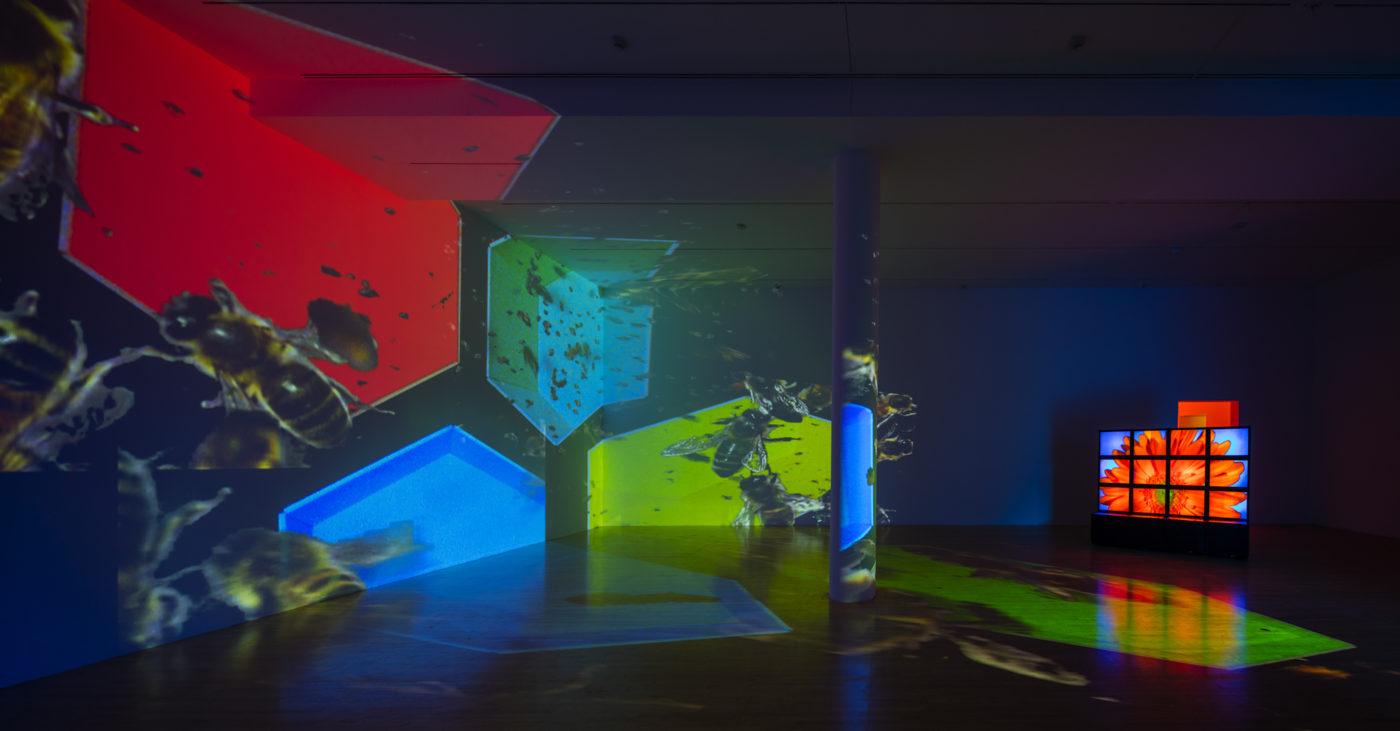what are the different approaches to art education?
Getting Started: An Introduction to Education with Contemporary Art
Contemporary Approaches to Educational activity

Diana Thater. knots + surfaces, 2001. 5 video projectors, 16 video monitors, half dozen DVD players, six DVDs, 1 distribution amplifier, Lee filters and existing compages; dimensions variable. Installation view: "Diana Thater: The Sympathetic Imagination," Los Angeles County Museum of Art, 2015. Photograph: © Fredrik Nilsen. Courtesy of David Zwirner, New York/London. © Diana Thater
Use themes and big ideas driven past essential questions to frame your investigation.
Integrating contemporary art and themes into teaching requires a shift from predominantly technique-driven pedagogy to idea-driven teaching. Many artists do non work in a unmarried medium or technique and instead try to explore an idea, issue, situation, or question through multiple media and visual strategies. Consider planning curriculum around a large idea, theme, or question first; so, decide what projects, skills, or materials volition back up meaningful investigation and expression. The big idea or theme should focus the investigation and create a unifying framework, in which you can include multiple resources, artworks, and artists.

Carrie Mae Weems. Mourning, 2008. Archival pigment print, 61 × 51 inches. © Carrie Mae Weems. Courtesy Jack Shainman Gallery, New York.

Judy Pfaff. Gu, Choki, Pa, 1985. Steel, wood, plastic, organic materials, bamboo, lattice, signs, veneer paneling, Formica, steel grating, and paint, xx × 40 (bore) feet. Installation view: Spiral / Wacoal Art Center, Tokyo, Japan. © Judy Pfaff.
Give students options: introduce multiple artists and media sources.
Avert mimicking the style or working methods of a single artist. Instead, introduce a range of artists who may have divergent ideas or approaches, and can offer multiple perspectives and working methods related to a chosen theme, idea, or question. Select the artists you bring to your classroom to include a combination of historic and gimmicky voices, also as perspectives from diverse cultures and worldviews.

Marina Abramović. Crystal Picture palace I, 1991. Quartz earthholder, wooden stoo.l Installation at Arte Amazonas, Museo del Arte Moderna, Rio de Janeiro Photo: Tomas Adel Courtesy the Marina Abramović Archives © Marina Abramović.
Push across a media-driven curriculum.
Increasingly, artists are making works that defy traditional media categories. Rarely referring to themselves as strictly painters or sculptors, artists utilize the most effective media, tools, and contexts for the ideas they want to limited. Provide opportunities for students to proceeds skills in materials that emphasize their thinking about ideas across media. Allow them to proceeds familiarity with multiple ways of representing and thinking through a specific theme or concept.

Tania Bruguera. Museum of Arte Útil, 2013–2014. Pictured: The Loompanics Room. Installation view: Van Abbemuseum, Eindhoven, The Netherlands. Photo: Peter Cox. Courtesy Studio Bruguera and the Van Abbemuseum, Eindhoven, Kingdom of the netherlands. © Tania Bruguera.
Call back and talk more; make less.
Encourage students to consider how contemporary artists become ideas, and where their inspiration comes from. Enquire them to consider the concept-the ideas, choices or decisions the artist fabricated to create the work (such as the option of materials, installation decisions, colour or paradigm choices). Why do they remember the creative person made those choices? What visual, literary and/or historical references do they see in the work? How does this piece of work of art tell us something well-nigh the earth nosotros live in?
Similarly, when students are making their own artwork, instead of rushing to first on artworks, enquire them to beginning consider the idea they are trying to express. Have students brainstorm ideas and questions on paper. Encourage them to discover creative person role models who are exploring similar ideas with diverse methods. Ask students to share their ideas and possible next steps with classmates and those outside the classroom. Help them think through multiple options before selecting a final idea to pursue. Appoint them in discussions that challenge and develop their ideas, in anticipation of realizing a work of art.

Pedro Reyes. pUN: People'due south United Nations, 2013-present. View of Queens Museum, New York, 2013. Photo: Ramiro Chaves. Courtesy of the creative person. © Pedro Reyes.
Emphasize process over product.
Rather than designing a curriculum with a final production or project in mind, consider different ways you can model how to develop and realize an idea. Plan backwards, to accost larger learning goals that nurture disquisitional-thinking and research skills, so that students can make meaningful works informed by well-researched and developed ideas.
Utilize themes and big ideas driven by essential questions to frame your investigation.
Integrating contemporary art and themes into teaching requires a shift from predominantly technique-driven instruction to idea-driven education. Many artists practice not work in a single medium or technique and instead try to explore an idea, event, state of affairs, or question through multiple media and visual strategies. Consider planning curriculum around a large idea, theme, or question first; then, decide what projects, skills, or materials will back up meaningful investigation and expression. The big idea or theme should focus the investigation and create a unifying framework, in which you can include multiple resources, artworks, and artists.
Apply themes and big ideas driven past essential questions to frame your investigation.
Integrating contemporary art and themes into teaching requires a shift from predominantly technique-driven teaching to idea-driven teaching. Many artists exercise not work in a single medium or technique and instead try to explore an idea, event, situation, or question through multiple media and visual strategies. Consider planning curriculum around a large idea, theme, or question first; then, decide what projects, skills, or materials will support meaningful investigation and expression. The big idea or theme should focus the investigation and create a unifying framework, in which you lot tin include multiple resources, artworks, and artists.
Carrie Mae Weems. Mourning, 2008. Archival pigment print, 61 10 51 inches. © Carrie Mae Weems. Courtesy Jack Shainman Gallery, New York.
Source: https://art21.org/for-educators/tools-for-teaching/getting-started-an-introduction-to-teaching-with-contemporary-art/contemporary-approaches-to-teaching/
0 Response to "what are the different approaches to art education?"
Post a Comment